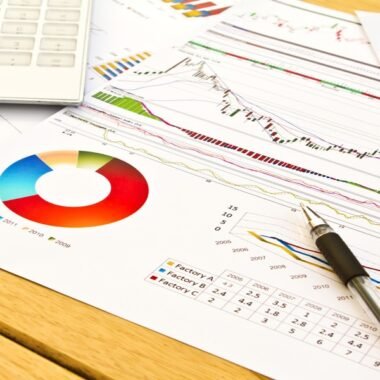Summary: Statistical Modeling is essential for Data Analysis, helping organisations predict outcomes and understand relationships between variables. It encompasses various models and techniques, applicable across industries like finance and healthcare, to drive informed decision-making.
Introduction
Statistical Modeling is crucial for analysing data, identifying patterns, and making informed decisions. It involves creating mathematical models to represent real-world processes, enabling predictions and better understanding of relationships between variables. In Data Analysis, Statistical Modeling is essential for drawing meaningful conclusions and guiding decision-making.
Industries like finance, healthcare, and marketing heavily rely on these models for tasks such as risk assessment, patient diagnosis, and consumer behaviour analysis. This blog aims to explain what Statistical Modeling is, highlight its key components, and explore its applications across various sectors.
What is Statistical Modeling?
Statistical Modeling uses mathematical frameworks to represent real-world data and make predictions, analyse relationships, or test hypotheses. It involves creating a simplified model that captures the essential patterns in the data, allowing for better understanding and decision-making.
These models are typically built using statistical theories and can be tailored to various fields such as economics, healthcare, and engineering.
How Statistical Models Work
Statistical Models use observed data to estimate relationships between different variables. A model begins with a set of assumptions about the data, which are then expressed as mathematical equations.
The model is trained on historical data to estimate the parameters best describing these relationships. Once built, the model can be used to make predictions about new data or evaluate the significance of certain factors.
For example, a simple linear regression model assumes a straight-line relationship between two variables. Based on the data, the model calculates the line’s slope and intercept, which can then be used to predict the outcome of a dependent variable given new input.
Key Objectives of Statistical Modeling
- Prediction: One of the primary goals of Statistical Modeling is to predict future outcomes based on historical data. This is especially useful in finance and weather forecasting, where predictions guide decision-making.
- Hypothesis Testing: Statistical Models help test hypotheses by analysing relationships between variables. Researchers use models to determine whether a certain factor significantly affects an outcome or if the result occurred by chance.
- Understanding Relationships: Statistical Modeling helps in understanding the relationships between variables. For instance, it can identify the impact of multiple factors on a single outcome, allowing businesses to optimise processes or improve product development.
Key Components of Statistical Models
Statistical Models are essential tools in Data Analysis, helping to identify patterns and make predictions. To understand how these models work, it’s important to recognise their key components. Each component is vital in determining the model’s accuracy and effectiveness. Below are the main components of Statistical Models:
Variables
Statistical Models rely on two types of variables—dependent and independent. The dependent variable is the outcome you’re trying to predict or explain, while the independent variables (also known as predictors) influence the dependent variable. Identifying the right variables is crucial for accurate modeling.
Parameters
These are the values that the model estimates to explain the relationship between independent and dependent variables. Parameters help quantify the effect of each independent variable on the dependent variable. For example, in linear regression, parameters are the coefficients that multiply the independent variables.
Model Structure
This defines how the variables and parameters are arranged. Models can be linear (where relationships between variables are straight-line) or nonlinear (where relationships curve or vary in complex ways). The structure choice depends on the nature of the data and the relationship you’re modeling.
Error Term
No model is perfect, and the error term accounts for the difference between the model’s predictions and actual outcomes. It represents variability that the model doesn’t explain.
Understanding these components is fundamental to building reliable Statistical Models that provide valuable insights into data.
Types of Statistical Models
Statistical Models come in various types, each serving a distinct purpose in analysing data and drawing insights. Understanding these types helps in selecting the right approach to solve specific problems. Below are the four main types of Statistical Models: descriptive, predictive, prescriptive, and inferential models.
Descriptive Models
Descriptive models summarise and describe a dataset’s main features. They focus on identifying patterns, relationships, and trends within the data without making predictions or suggesting decisions. These models help understand historical data and form a foundation for deeper analysis. For example, descriptive models commonly use frequency distributions and summary statistics (mean, median, mode).
Predictive Models
Predictive models are designed to forecast future outcomes based on historical data. They identify patterns in existing data and use them to predict unknown events. Predictive modeling is widely used in finance, healthcare, and marketing.
Techniques like linear regression, time series analysis, and decision trees are examples of predictive models. These models enable businesses to anticipate customer behaviour, forecast sales, or predict risks.
Prescriptive Models
Prescriptive models go further than predictive models by recommending specific actions based on the predictions. They help decision-making by suggesting the best course of action to achieve desired outcomes.
Optimisation models and simulation techniques are often used in prescriptive modeling. A common application is supply chain management, where prescriptive models recommend inventory levels based on predicted demand.
Inferential Models
Inferential models are used to make generalisations or inferences about a population based on a sample of data. These models help in hypothesis testing and determining the relationships between variables. Bayesian models and hypothesis tests (like t-tests or chi-square tests) are examples of inferential models. They are essential in scientific research for concluding limited data.
Each type of Statistical Model plays a unique role, providing valuable insights for decision-making and problem-solving.
Common Statistical Modeling Techniques
Statistical Modeling techniques are essential for analysing data, identifying patterns, and making predictions. These techniques vary in complexity and are applied based on the nature of the data and the problem at hand. Below are some of the most commonly used Statistical Modeling techniques and an overview of their applications.
Linear Regression
Linear regression is one of the simplest and most widely used statistical techniques. It models the relationship between a dependent variable and one or more independent variables by fitting a linear equation to the observed data. The goal is to predict the dependent variable based on the values of the independent variables.
Applications:
- Forecasting sales or revenue trends
- Estimating the impact of marketing campaigns
- Predicting housing prices based on features such as location, size, and amenities
Logistic Regression
Unlike linear regression, logistic regression is used when the dependent variable is categorical. It estimates the probability that a given input falls into two categories. The model uses a logistic function to map predicted values to probabilities between 0 and 1.
Applications:
- Binary classification tasks, such as spam detection
- Predicting customer churn in subscription-based businesses
- Medical diagnosis, such as determining whether a patient has a disease (yes/no)
Time Series Models
Time series models analyse data points collected or observed at successive points in time. They capture trends, seasonal patterns, and cyclical behaviour in time-dependent data. The most commonly used time series techniques include ARIMA (AutoRegressive Integrated Moving Average) and exponential smoothing.
Applications:
- Stock price prediction and financial forecasting
- Analysing sales trends over time
- Demand forecasting in supply chain management
Clustering Models
Clustering is an unsupervised learning technique used to group similar data points together. These models do not rely on predefined labels; instead, they discover the inherent structure in the data by identifying clusters based on similarities. Popular clustering algorithms include k-means and hierarchical clustering.
Applications:
- Customer segmentation in marketing
- Identifying patterns in image recognition tasks
- Grouping similar documents or news articles for topic discovery
Decision Trees
Decision trees are non-parametric models that partition the data into subsets based on specific criteria. At each node in the tree, the data is split based on the value of an input variable, and the process is repeated recursively until a decision is made.
This technique is easy to interpret and visualise, making it a popular choice for classification and regression tasks.
Applications:
- Credit risk analysis for loan approval
- Predicting patient outcomes in healthcare
- Fraud detection in financial transactions
These Statistical Modeling techniques are foundational tools for solving various industry data-related problems. Each method offers unique strengths and is selected based on the specific nature of the dataset and the business problem to be addressed.
Steps in Building a Statistical Model
Building a Statistical Model involves structured steps to transform raw data into meaningful insights. Each phase ensures the model’s accuracy, reliability, and predictive power.
By following a systematic approach, you can optimise the performance of your Statistical Model and ensure it meets the needs of the problem you’re solving. Below are the essential steps involved in the process.
Data Collection and Preparation
The first and most critical step in building a Statistical Model is gathering and preparing the data. Quality data is essential, as poor or incomplete data can lead to inaccurate models. Start by collecting data relevant to your problem, ensuring it’s diverse and representative.
After collecting the data, focus on data cleaning, which includes handling missing values, correcting errors, and ensuring consistency.
Data preparation also involves feature engineering. This step allows you to transform raw variables into meaningful features that will help improve the model’s performance. Data normalisation and standardisation ensure variables are on the same scale, especially in models sensitive to variable magnitudes.
Model Selection
After preparing the data, the next step is selecting the right Statistical Model. The choice of model depends on the nature of the data and the problem you’re solving.
For instance, linear regression models work well for continuous outcomes, while logistic regression is ideal for binary classification problems. In more complex cases, you may need to explore non-linear models like decision trees, support vector machines, or time series models.
Model selection requires balancing simplicity and performance. While more complex models may offer higher accuracy, they can be harder to interpret and prone to overfitting.
Model Training
Once the model is selected, you train it using the dataset. During training, the model learns from the input data by identifying patterns and relationships between the independent and dependent variables.
Model training involves optimising parameters to minimise errors and improve prediction accuracy. Splitting your data into training and test sets is essential to ensure the model doesn’t memorise the data but instead learns generalisable patterns.
Model Validation
Model validation is a critical step to evaluate the model’s performance on unseen data. You should use techniques like cross-validation, where the data is divided into subsets, and the model is trained and validated on different splits.
This helps ensure that the model performs well across different data samples and is not overfitted to the training data.
Interpretation of Results
Once the model trained and validated, it’s time to interpret the results. Examine the model’s output to understand the relationships between variables and whether the predictions align with the problem’s objectives.
Interpretation helps in explaining the model to stakeholders, allowing for actionable decisions based on the insights gained. Pay attention to key metrics like accuracy, precision, recall, and R-squared values to assess the model’s effectiveness.
Iterative Nature of Model Building and Tuning
Building a Statistical Model is rarely a one-time task. The process is iterative, requiring continuous fine-tuning to improve performance. After evaluating the model’s results, you may need to return to earlier stages to adjust parameters, try different models, or modify the data.
This iterative approach helps in refining the model until it achieves the desired accuracy and reliability for real-world applications.
By understanding these steps, you can develop robust Statistical Models that provide valuable insights and drive informed decision-making.
Statistical Modeling Tools and Software
Statistical Modeling requires the right tools to analyse data and build models efficiently. These tools help simplify complex calculations, visualise data, and test hypotheses. Here are some widely use Statistical Modeling tools and software:
- R: A powerful open-source language for statistical analysis and data visualisation.
- Python: Popular for its libraries like NumPy, pandas, and scikit-learn, which are great for data manipulation and modeling.
- SPSS: A user-friendly tool for statistical analysis, often used in social sciences.
- SAS: A robust software suite for advanced analytics, business intelligence, and data management.
Challenges in Statistical Modeling
Statistical Modeling is a powerful tool for Data Analysis, but several challenges can impact the accuracy and reliability of the results. Overcoming these issues is critical to building robust models that offer meaningful insights.
- Overfitting vs. Underfitting: Overfitting happens when a model fits the training data too closely, while underfitting occurs when it fails to capture key patterns.
- Multicollinearity: Highly correlated variables can distort model outcomes.
- Data Quality: Incomplete or inaccurate data can lead to unreliable results.
- Model Interpretability: Complex models can be difficult to explain and understand.
Applications of Statistical Modeling
Statistical Modeling is crucial across various industries, providing insights that drive decision-making and enhance efficiency. Here are some key applications:
- Healthcare: Used for predicting patient outcomes, analysing treatment effectiveness, and optimising resource allocation.
- Finance: Assists in risk assessment, fraud detection, and portfolio management through predictive analytics.
- Marketing: Helps in customer segmentation, campaign effectiveness evaluation, and sales forecasting.
- Manufacturing: Optimises production processes and quality control through statistical process control.
- Environmental Science: Models climate change impacts and assesses environmental risks.
These applications demonstrate the versatility and importance of Statistical Modeling in solving real-world problems.
Closing Statements
Statistical Modeling is vital in Data Analysis, enabling organisations to predict outcomes, test hypotheses, and understand complex relationships between variables. Its applications across various industries, from healthcare to finance, highlight its significance in making informed decisions. By leveraging the right techniques and tools, businesses can derive valuable insights for growth and efficiency.
Frequently Asked Questions
What is Statistical Modeling?
Statistical Modeling uses mathematical frameworks to represent real-world data, enabling predictions and analyses of relationships between variables. It simplifies complex processes, allowing better decision-making across various fields.
What are the Types of Statistical Models?
The main types of Statistical Models include descriptive, predictive, prescriptive, and inferential models. Each serves a unique purpose, from summarising data to making predictions and recommendations for decision-making.
How is Statistical Modeling Applied in Healthcare?
In healthcare, Statistical Modeling predicts patient outcomes, evaluates treatment effectiveness, and optimises resource allocation. These models provide insights that enhance patient care and improve operational efficiency.




